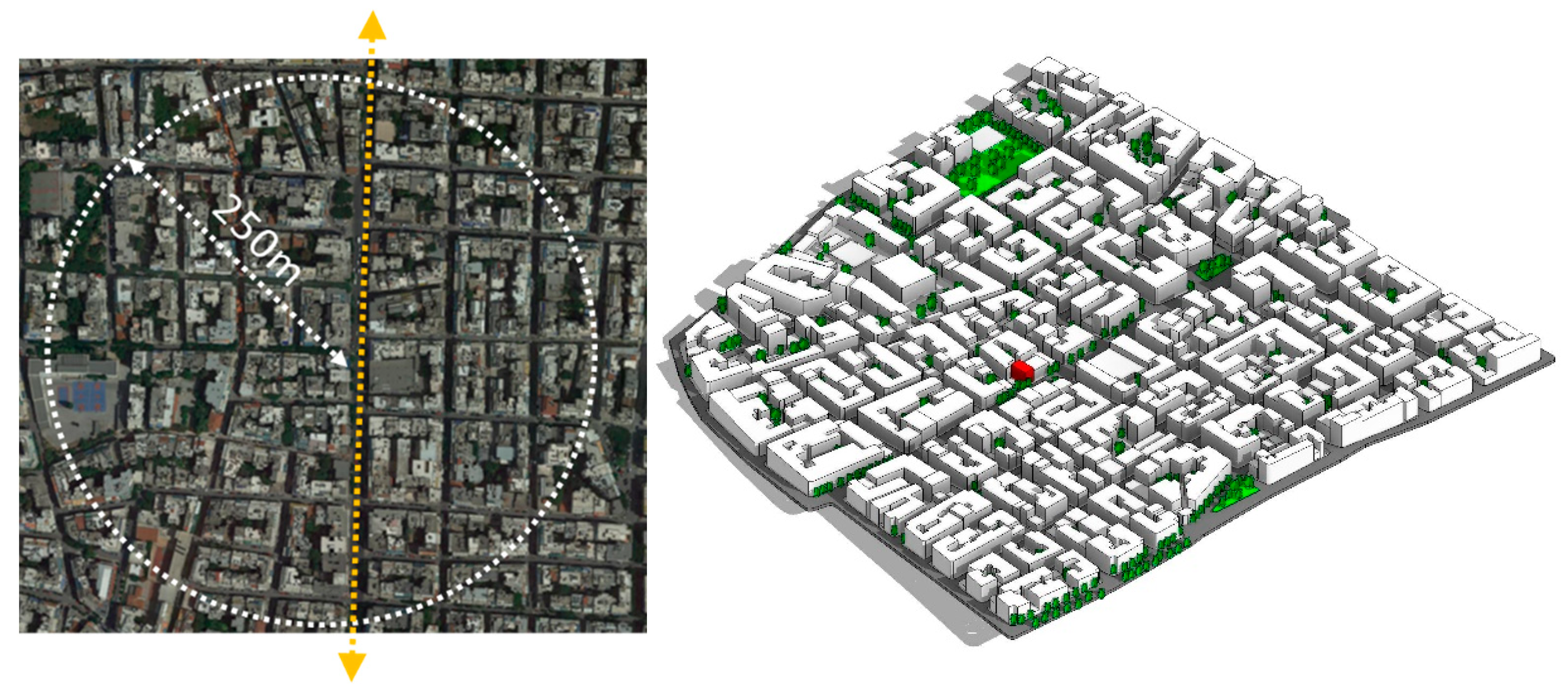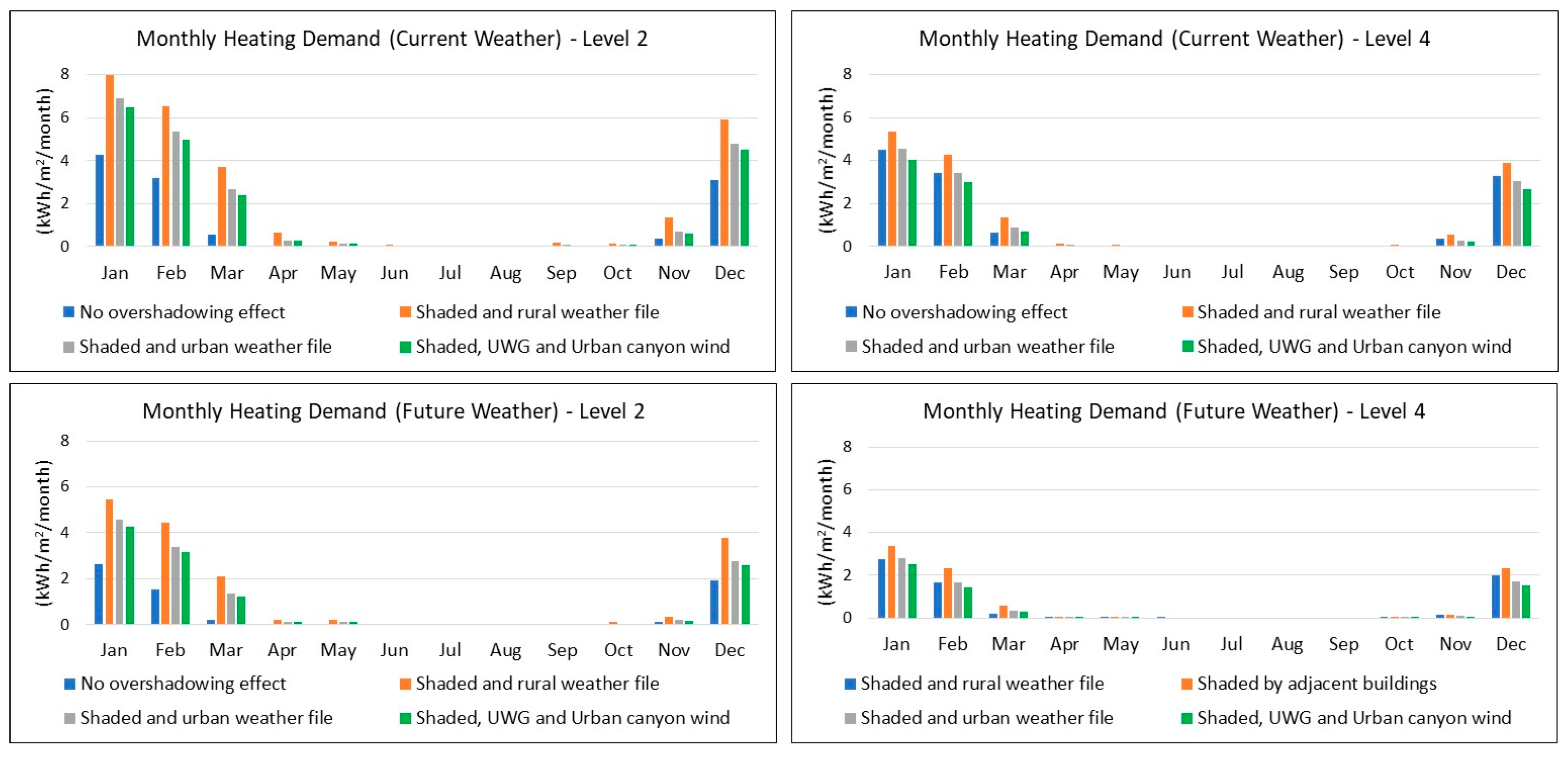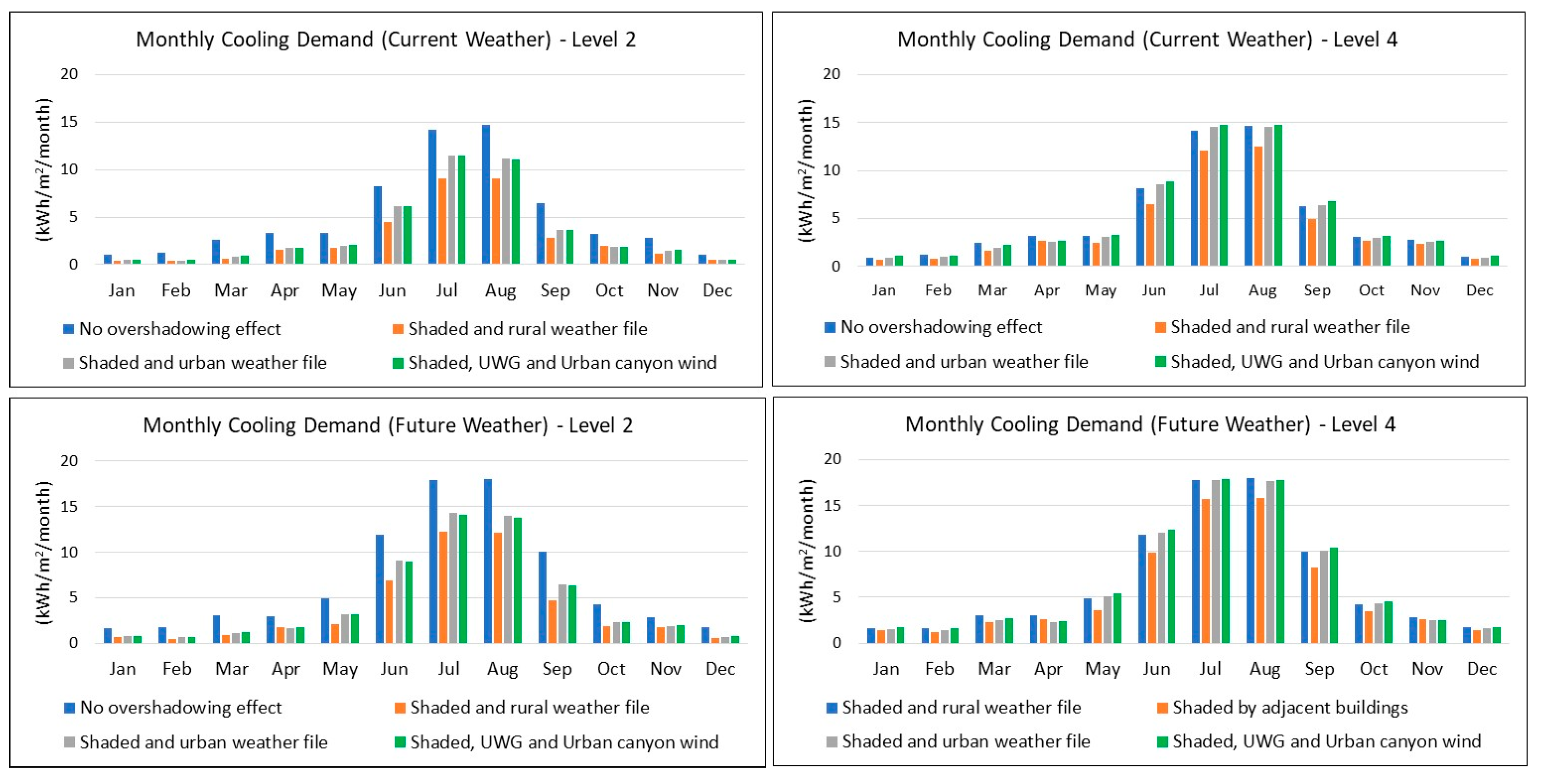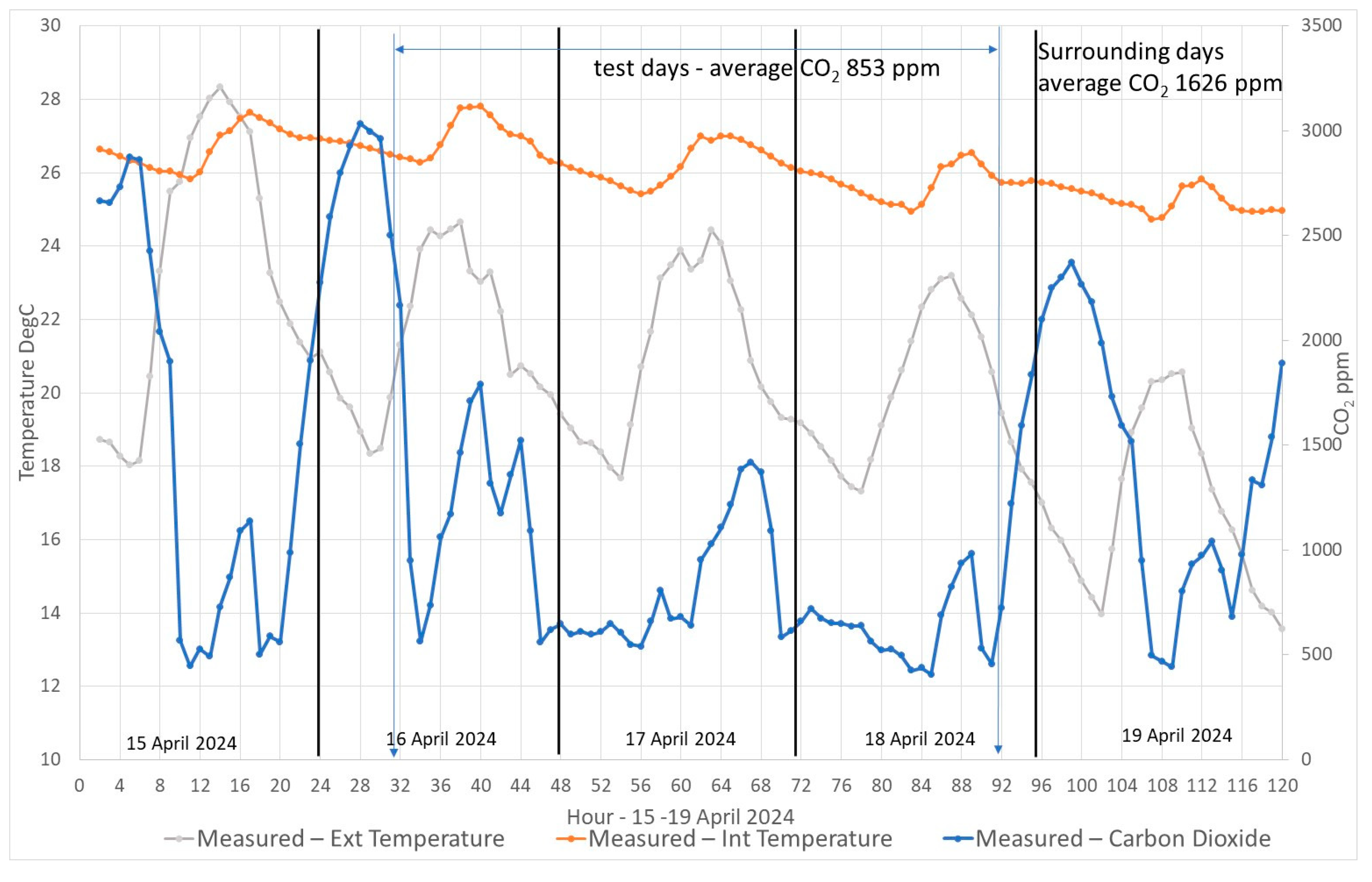Impact of the Urban Environment on the Thermal Performance and Environmental Quality of Residential Buildings: A Case Study in Athens †
Abstract
1. Introduction
2. Materials and Methods
2.1. Case Study Location and Building Description
2.2. Methodology for Generating Urban Weather Files

- Building density: the ratio of the building footprints area to the urban site area.
- Vertical-to-horizontal ratio: the ratio of the building facades area to the urban site area.
- Average building height: the average height of building normalized by the building footprint.
2.3. Development of Climate Correlation Models
2.4. Tests of the Climate Correlation Model
- Tuesday, 16 April and Wednesday, 17 April
- Close the window at 8 in the morning
- Open the window at 3 for one hour
- Open the window at 8 pm and leave it open during the night (and then close it at 8 in the morning).
- The window does not need to be completely open, just ajar, for example, 10 cm of opening (whatever is convenient—it does not matter how much it is open as long as it is open).
- If it is too cold at night, then they should close it and just tell us.
- Curtains should be closed between 3 p.m. and 6 p.m.
3. Results and Discussion
3.1. Comparison of Weather Files
3.2. Annual Energy Demand
3.3. Monthly Energy Demand
3.4. Results of Climate Correlation Intervention Study
4. Conclusions
- The heating demand could decrease in future, while the cooling demand could increase due to the increase in outdoor dry bulb temperature.
- Results vary with the height of the space, with higher floors demanding less energy for heating and higher energy for cooling, and this is mainly due to overshadowing, which changes solar gains.
- There are increased external temperatures due the UHI decrease heating energy demand and increased cooling energy demand when overshadowing is also considered.
- The urban canyon wind caused lower wind speed, which influences energy consumption (due to changes in infiltration rates). This is more pronounced for the heating demand.
- There are extensive periods in the year when both heating and cooling energy demand is very low; thus, the building could be used in a free floating (no cooling, heating, or mechanical ventilation) mode during these periods.
5. Limitations and Further Research
Author Contributions
Funding
Data Availability Statement
Acknowledgments
Conflicts of Interest
References
- Heiselberg, P. (Ed.) EBC Annex 62 Ventilative Cooling: Project Summary Report; IEA EBC: Canberra, Australia, 2019; Available online: https://www.iea-ebc.org/Data/publications/EBC_SR_Annex62.pdf (accessed on 5 March 2025).
- Morales, R.D.; Audenaert, A.; Verbeke, S. Thermal comfort and indoor overheating risks of urban building stock—A review of modelling methods and future climate challenge. Build. Environ. 2024, 269, 112363. [Google Scholar] [CrossRef]
- Bueno, B.; Roth, M.; Norford, L.; Li, R. Computationally efficient prediction of canopy level urban air temperature at the neighbourhood scale. Urban. Clim. 2014, 9, 35–53. [Google Scholar] [CrossRef]
- Jusuf, S.K.; Wong, N.H. Development of Empirical Models For an Estate Level Air Temperature Prediction in Singapore, Berkeley, United States. In Proceedings of the 7th International Conference on Urban Climate, Yokohama, Japan, 29 June–3 July 2009. [Google Scholar]
- Kershaw, T.; Sanderson, M.; Coley, D.; Eames, M. Estimation of the urban heat island for UK climate change projections. Build. Serv. Eng. Res. Technol. 2010, 31, 251–263. [Google Scholar] [CrossRef]
- De Ridder, K.; Lauwaet, D.; Maiheu, B. UrbClim—A fast urban boundary layer climate model. Urban. Clim. 2015, 12, 21–48. [Google Scholar] [CrossRef]
- Mauree, D.; Coccolo, S.; Kaempf, J.; Scartezzini, J.-L. Multi-scale modelling to evaluate building energy consumption at the neighbourhood scale. PLoS ONE 2017, 12, e0183437. [Google Scholar] [CrossRef]
- Fahssis, K.; Dupont, G.; Leyronnas, P. UrbaWind, A Computational Fluid Dynamics Tool to Predict Wind Resource in Urban Area. 2010. Available online: https://www.scribd.com/document/151322723/UrbaWind-a-Computational-Fluid-Dynamics-tool-to-predict-wind-resource-in-urban-area (accessed on 5 March 2025).
- Bruse, M.; Fleer, H. Simulating surface–plant–air interactions inside urban environments with a three dimensional numerical model. Environ. Model. Softw. 1998, 13, 373–384. [Google Scholar] [CrossRef]
- Merlier, L.; Frayssinet, L.; Kuznik, F.; Rusaoue¨n, G.; Johannes, K.; Hubert, J.-L.; Milliez, M. Analysis of the (Urban) Microclimate Effects On the Building Energy Behaviour; IBPSA: Fairfax, VA, USA, 2017; pp. 1780–1787. [Google Scholar] [CrossRef]
- Jentsch, M.F.; James, P.A.B.; Bourikas, L.; Bahaj, A.S. Transforming existing weather data for worldwide locations to enable energy and building performance simulation under future climates. Renew. Energy 2013, 55, 514–524. [Google Scholar] [CrossRef]
- Moazami, A.; Carlucci, S.; Geving, S. Critical Analysis of Software Tools Aimed at Generating Future Weather Files with a view to their use in Building Performance Simulation. Energy Procedia 2017, 132, 640–645. [Google Scholar] [CrossRef]
- Jiang, A.; Liu, X.; Czarnecki, E.; Zhang, C. Hourly weather data projection due to climate change for impact assessment on building and infrastructure, Sustain. Cities Soc. 2019, 50, 101688. [Google Scholar] [CrossRef]
- Meteonorm Software. Available online: https://meteonorm.com/en/ (accessed on 5 March 2025).
- Lauwaet, D.; Hooyberghs, H.; Maiheu, B.; Lefebvre, W.; Driesen, G.; Van Looy, S.; De Ridder, K. Detailed Urban Heat Island Projections for Cities Worldwide: Dynamical Downscaling CMIP5 Global Climate Models. Climate 2015, 3, 391–415. [Google Scholar] [CrossRef]
- Machard, A.; Salvati, A.; Tootkaboni, M.P.; Gaur, A.; Zou, J.; Wang, L.L.; Baba, F.; Ge, H.; Bre, F.; Bozonnet, E.; et al. Typical and extreme weather datasets for studying the resilience of buildings to climate change and heatwaves. Sci. Data 2024, 11, 531. [Google Scholar] [CrossRef]
- Sulzer, M.; Christen, A.; Matzarakis, A. Predicting indoor air temperature and thermal comfort in occupational settings using weather forecasts, indoor sensors, and artificial neural networks. Build. Environ. 2023, 234, 110077. [Google Scholar] [CrossRef]
- Kalidindi, S.S.V.; Banaee, H.; Karlsson, H.; Loutfi, A. Indoor temperature prediction with context-aware models in residential buildings. Build. Environ. 2023, 244, 110772. [Google Scholar] [CrossRef]
- Schweizer, C.; Edwards, R.D.; Bayer-Oglesby, L.; Gauderman, W.J.; Ilacqua, V.; Jantunen, M.J.; Lai, H.K.; Nieuwenhuijsen, M.; Künzli, N. Indoor time–microenvironment–activity patterns in seven regions of Europe. J. Expo. Sci. Environ. Epidemiol. 2007, 17, 170–181. [Google Scholar] [CrossRef] [PubMed]
- Givoni, B. Passive and Low Energy Cooling of Buildings; Van Nostrand Reinhold: New York, NY, USA, 1994. [Google Scholar]
- Manzano-Agugliaro, F.; Montoya, F.G.; Sabio-Ortega, A.; García-Cruz, A. Review of bioclimatic architecture strategies for achieving thermal comfort. Renew. Sustain. Energy Rev. 2015, 49, 736–755. [Google Scholar] [CrossRef]
- Ozarisoy, B.; Altan, H. Systematic literature review of bioclimatic design elements: Theories, methodologies and cases in the South-eastern Mediterranean climate. Energy Build. 2021, 250, 111281. [Google Scholar] [CrossRef]
- Elaouzy, Y.; Fadar, A.E. Energy, economic and environmental benefits of integrating passive design strategies into buildings: A review. Renew. Sustain. Energy Rev. 2022, 167, 112828. [Google Scholar] [CrossRef]
- Kolokotroni, M.; May, Z.; Tun, T.P.; Christantoni, I.; Tsakanika, D. Urban context and climate change impact on the thermal performance and ventilation of residential buildings: A case-study in Athens. In Proceedings of the 43nd AIVC Conference: Ventilation, IEQ and Health in Sustainable Buildings, Copenhagen, Denmark, 4–5 October 2023. [Google Scholar]
- Kolokotroni, M.; May, Z.; Tun, T.P.; Christantoni, I.; Tsakanika, D.; Stawowczyk, D.; de Kerchove d’Exaerde, T. Intervention study of climate correlation model predictions for occupant control of indoor environment. In Proceedings of the 44nd AIVC Conference: Retrofitting the Building Stock: Challenges and Opportunities for Indoor Environmental Quality, Dublin, Ireland, 9–10 October 2024. [Google Scholar]
- BS EN 16798-1; Energy Performance of Buildings. Ventilation for Buildings. Indoor Environmental Input Parameters for Design and Assessment of Energy Performance of Buildings Addressing Indoor Air Quality, Thermal Environment, Lighting, and Acoustics. Module M1-6. BSI: London, UK, 2019.
- Bueno, B.; Norford, L.; Hidalgo, J.; Pigeon, G. The urban weather generator. J. Build. Perform. Simul. 2013, 6, 269–281. [Google Scholar] [CrossRef]
- Mao, J.; Yang, J.H.; Afshari, A.; Norford, L.K. Global sensitivity analysis of an urban microclimate system under uncertainty: Design and case study. Build. Environ. 2017, 124, 153–170. [Google Scholar] [CrossRef]
- Bueno, B.; Norford, L.; Pigeon, G.; Britter, R. Combining a detailed building energy model with a physically-based urban canopy model. Bound.-Lay. Meteorol. 2011, 140, 471–489. [Google Scholar] [CrossRef]
- Bueno, B.; Hidalgo, J.; Pigeon, G.; Norford, L.; Masson, V. Calculation of air temperatures above the urban canopy layer from measurements at a rural operational weather station. J. Appl. Meteorol. Climatol. 2013, 52, 472–483. [Google Scholar] [CrossRef]
- Mao, J. UWG V4 MATLAB Code. 2018. Available online: https://github.com/hansukyang/UWG_Matlab (accessed on 5 March 2025).
- IPCC. Synthesis Report. In Contribution of Working Groups I, II and III to the Fifth Assessment Report of the Intergovernmental Panel on Climate Change; IPCC: Geneva, Switzerland, 2014. [Google Scholar]
- Salvati, A.; Palme, M.; Chiesa, G.; Kolokotroni, M. Built form, urban climate and building energy modelling: Case-studies in rome and Antofagasta. J. Build. Perform. Simul. 2020, 13, 209–225. [Google Scholar] [CrossRef]
- Nakano, A. Urban Weather Generator User Interface Development: Towards a Usable Tool for Integrating Urban Heat Island Effect Within Design Process. 2015, pp. 1–141. Available online: https://dspace.mit.edu/handle/1721.1/99251 (accessed on 5 March 2025).
- Salvati, A.; Kolokotroni, M. Microclimate Data For Building Energy Modelling: Study On ENVI-Met Forcing Data. In Proceedings of the 16th IBPSA Conference, Rome, Italy, 2–4 September 2019; Corrado, V., Gasparella, A., Eds.; pp. 3361–3368. [Google Scholar]
- Salvati, A.; Coch, H.; Cecere, C. Urban Heat Island Prediction in the Mediterranean Context: An Evaluation of the Urban Weather Generator Model. ACE Archit. City Environ. Arquit. Ciudad. Entorno 2016, 11, 135–156. [Google Scholar] [CrossRef]
- Stewart, I.D.; Oke, T.R. Local Climate Zones for Urban Temperature Studies. Bull. Am. Meteorol. Soc. 2012, 93, 1879–1900. [Google Scholar] [CrossRef]
- Ghiaus, C.; Allard, F.; Santamouris, M.; Georgakis, C.; Roulet, C.A.; Germano, M.; Tillenkamp, F.; Heijmans, N.; Nicol, J.; Maldonado, E.; et al. Natural Ventilation of Urban Buildings-Summary of URBVENT Project. In Proceedings of the International Conference “Passive and Low Energy Cooling for the Built Environment”, Santorini, Greece, 19–21 May 2005; pp. 29–33. [Google Scholar]
- Salvati, A.; Kolokotroni, M. Urban microclimate and climate change impact on the thermal performance and ventilation of multi-family residential buildings. Energy Build. 2023, 1132, 29424. [Google Scholar] [CrossRef]
- Hostein, M.; Musy, M.; Moujalled, B.; El Mankibi, M. Generating meteorological files of future climates with heatwaves in urban context to evaluate building overheating: An energy-efficient dwelling case study. Build. Environ. 2024, 263, 111874. [Google Scholar] [CrossRef]
- Design Builder Software. Available online: https://designbuilder.co.uk/ (accessed on 5 March 2025).
- PRELUDE: Prescient Building Operation Utilizing Real-Time Data for Energy Dynamic Optimization. 2025. Available online: https://prelude-project.eu/ (accessed on 5 March 2025).
- Zune, M.; Kolokotroni, M. Climate correlation model to forecast thermal comfort and IAQ in naturally ventilated residential buildings. In Proceedings of the 42nd AIVC Conference: Ventilation Challenges in a Changing World, Rotterdam, The Netherlands, 5–6 October 2022. [Google Scholar]
- Zune, M.; Kolokotroni, M. D3.4: Indoor-Outdoor Correlation Module. PRELUDE Project WP3: Interoperable Dynamic Module Integration in Multisimulation Dataspace. 2022. Available online: https://prelude-project.eu/results/deliverables/ (accessed on 5 March 2025).
- Open Meteo, Free Weather API. Available online: https://open-meteo.com (accessed on 5 March 2025).
- Kim, S.W.; Brown, R.D. Urban heat island (UHI) intensity and magnitude estimations: A systematic literature review. Sci. Total Environ. 2021, 779, 146389. [Google Scholar] [CrossRef]
- Rajagopal, P.; Priya, R.S.; Senthil, R. A review of recent developments in the impact of environmental measures on urban heat island. Sustain. Cities Soc. 2023, 88, 104279. [Google Scholar] [CrossRef]
- Duan, Z.; de Wilde, P.; Attia, S.; Zuo, J. Challenges in predicting the impact of climate change on thermal building performance through simulation: A systematic review. Appl. Energy 2025, 382, 125331. [Google Scholar] [CrossRef]
- HOBO MX CO2 Logger. Available online: https://www.tempcon.co.uk/hobo-mx1102-bluetooth-co2-temp-rh-data-logger (accessed on 5 March 2025).
- Jara-Baeza, F.; Rajagopalan, P.; Andamon, M.M. The impact of occupants’ window opening behaviour during summertime overheating in high-rise social housing. Energy Build. 2025, 330, 115331. [Google Scholar] [CrossRef]













| Building Envelope | Thermal Transmittance (W/m2 K) |
|---|---|
| External wall | 1.739 |
| Party wall | 2.038 |
| Ground floor | 1.834 |
| Internal floor | 0.788 |
| Roof | 0.639 |
| Internal door | 2.672 |
| Window | 2.5 (light transmission 0.78) |
| Urban Characteristics | Input Data | Vegetation Parameters | Input Data |
|---|---|---|---|
| Average Building Height | 15.78 | Urban Area Veg Coverage | 0.0157 |
| Fraction of Waste Heat into the Canyon | 1 | Urban Area Tree Coverage | 0.0245 |
| Building Density | 0.473 | Veg Start Month | 1 |
| Vertical-to-Horizontal Ratio | 1.078 | Veg End Month | 12 |
| Urban Area Characteristic Length | 250 | Vegetation Albedo | 0.25 |
| Max Dx | 62.5 | Latent Fraction of Grass | 0.5 |
| Road Albedo | 0.1 | Latent Fraction of Tree | 0.5 |
| Pavement Thickness | 0.5 | Rural Road Vegetation Coverage | 0.8 |
| Sensible Anthropogenic Heat (Peak) | 20 | ||
| Latent Anthropogenic Heat (Peak) | 2 |
| Scenario | Correlation Parameters | The Coefficient of Determination () | Correlation Equation for Thermal Comfort and Ventilation | |||
|---|---|---|---|---|---|---|
| Outdoor (x) | Indoor (y) | Window Closed | Window Open | Window Closed | Window Open | |
| 1 | DBT | OT | 0.8083 | n/a | n/a | |
| WS | ACH | 0.3025 | ||||
| IVT | ACH | 0.0038 | ||||
| 2 | DBT | OT | 0.8058 | 0.9038 | ||
| WS | ACH | 0.2777 | n/a | n/a | ||
| IVT | ACH | 0.0021 | 0.9239 | |||
| 3 | DBT | OT | 0.6825 | 0.8371 | ||
| WS | ACH | 0.3241 | n/a | n/a | ||
| IVT | ACH | n/a | 0.7947 | n/a | ||
| Weather File | Heating | Change Ratio | Cooling | Change Ratio | Total | Change Ratio |
|---|---|---|---|---|---|---|
| Overshadowing Included | kWh/m2/Year | kWh/m2/Year | kWh/m2/Year | |||
| Building Level 2 | ||||||
| Current Weather | 26.8 | 34 | 60.8 | |||
| Current Urban Weather (UWG) | 21.1 | 0.79 | 41.9 | 1.23 | 63.8 | 1.05 |
| Current UWG, Urban Canyon Wind | 19.5 | 0.73 | 42.1 | 1.24 | 62.3 | 1.03 |
| Future Weather | 16.7 | 0.62 | 46.6 | 1.37 | 63.9 | 1.05 |
| Future Urban Weather (UWG) | 12.6 | 0.47 | 56.4 | 1.66 | 69.5 | 1.14 |
| Future UWG, Urban Canyon Wind | 11.7 | 0.44 | 56.4 | 1.66 | 68.5 | 1.13 |
| Building Level 4 | ||||||
| Current Weather | 15.7 | 50.4 | 66.1 | |||
| Current Urban Weather (UWG) | 12.3 | 0.78 | 60.0 | 1.19 | 73.1 | 1.11 |
| Current UWG, Urban Canyon Wind | 10.8 | 0.69 | 62.5 | 1.24 | 74.0 | 1.12 |
| Future Weather | 8.9 | 0.57 | 68.3 | 1.36 | 77.8 | 1.18 |
| Future Urban Weather (UWG) | 6.7 | 0.43 | 78.9 | 1.57 | 86.0 | 1.30 |
| Future UWG, Urban Canyon Wind | 5.9 | 0.38 | 81.2 | 1.61 | 87.5 | 1.32 |
| Roof (Penthouse) | ||||||
| Current UWG, Urban Canyon Wind | 20.97 | 0.78 | 70.53 | 2.63 | 92.3 | 1.52 |
| Future UWG, Urban Canyon Wind | 12.18 | 0.45 | 93.75 | 3.50 | 106.4 | 1.75 |
Disclaimer/Publisher’s Note: The statements, opinions and data contained in all publications are solely those of the individual author(s) and contributor(s) and not of MDPI and/or the editor(s). MDPI and/or the editor(s) disclaim responsibility for any injury to people or property resulting from any ideas, methods, instructions or products referred to in the content. |
© 2025 by the authors. Licensee MDPI, Basel, Switzerland. This article is an open access article distributed under the terms and conditions of the Creative Commons Attribution (CC BY) license (https://creativecommons.org/licenses/by/4.0/).
Share and Cite
Kolokotroni, M.; Zune, M.; Gratton, P.; Tun, T.P.; Christantoni, I.; Tsakanika, D. Impact of the Urban Environment on the Thermal Performance and Environmental Quality of Residential Buildings: A Case Study in Athens. Energies 2025, 18, 2062. https://doi.org/10.3390/en18082062
Kolokotroni M, Zune M, Gratton P, Tun TP, Christantoni I, Tsakanika D. Impact of the Urban Environment on the Thermal Performance and Environmental Quality of Residential Buildings: A Case Study in Athens. Energies. 2025; 18(8):2062. https://doi.org/10.3390/en18082062
Chicago/Turabian StyleKolokotroni, Maria, May Zune, Petra Gratton, Thet Paing Tun, Ilia Christantoni, and Dimitra Tsakanika. 2025. "Impact of the Urban Environment on the Thermal Performance and Environmental Quality of Residential Buildings: A Case Study in Athens" Energies 18, no. 8: 2062. https://doi.org/10.3390/en18082062
APA StyleKolokotroni, M., Zune, M., Gratton, P., Tun, T. P., Christantoni, I., & Tsakanika, D. (2025). Impact of the Urban Environment on the Thermal Performance and Environmental Quality of Residential Buildings: A Case Study in Athens. Energies, 18(8), 2062. https://doi.org/10.3390/en18082062








